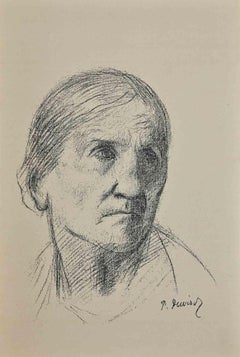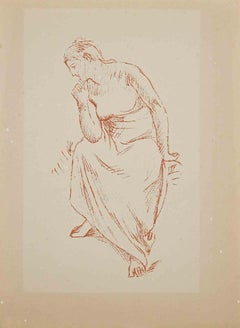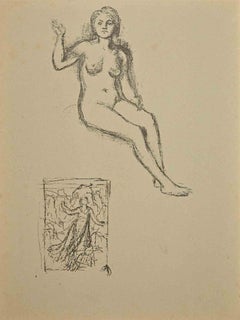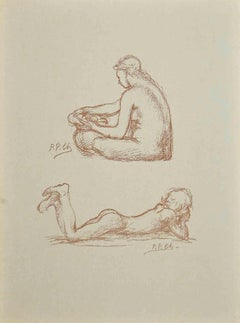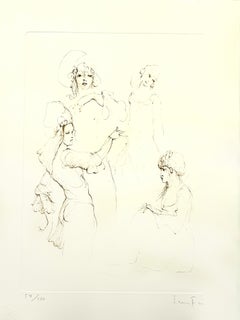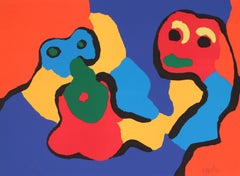Pierre Puvis de Chavannes Art
1
to
6
2
4
5
1
6
Overall Height
to
Overall Width
to
6
6
5
4
3
2
1
1
6
6
6,886
3,209
2,514
1,217
5
1
Artist: Pierre Puvis de Chavannes
Saint Jean Le Baptiste - Etching by P. Puvis de Chavannes - Late 19th Century
By Pierre Puvis de Chavannes
Located in Roma, IT
Jean-Baptiste is an original Etching realized by Pierre Puvis de Chavannes in the late 19th Century.
Good Conditions.
The artwork is depicted through soft strokes in a well-balance...
Category
Late 19th Century Modern Pierre Puvis de Chavannes Art
Materials
Etching
Portrait - Original Lithograph by P. Puvis de Chavannes - Late 19th Century
By Pierre Puvis de Chavannes
Located in Roma, IT
Portrait is an original lithograph realized by Pierre Puvis de Chavannes in the 19th Century.
Good Conditions.
The artwork is depicted through soft strokes in a well-balanced compo...
Category
Late 19th Century Modern Pierre Puvis de Chavannes Art
Materials
Lithograph
Nude - Original Lithograph by P. Puvis de Chavannes - Late 19th Century
By Pierre Puvis de Chavannes
Located in Roma, IT
Nude is an original lithograph realized by Pierre Puvis de Chavannes in the 19th Century.
Good Conditions.
The artwork is depicted through soft strokes in a well-balanced composition.
Category
Late 19th Century Modern Pierre Puvis de Chavannes Art
Materials
Lithograph
Woman - Original Lithograph by P. Puvis de Chavannes - Late 19th Century
By Pierre Puvis de Chavannes
Located in Roma, IT
Woman is an original lithograph realized by Pierre Puvis de Chavannes in the 19th Century.
Good Conditions.
The artwork is depicted through soft strokes in a well-balanced composit...
Category
Late 19th Century Modern Pierre Puvis de Chavannes Art
Materials
Lithograph
Nude - Original Lithograph by P. Puvis de Chavannes - Late 19th Century
By Pierre Puvis de Chavannes
Located in Roma, IT
Nude is an original lithograph realized by Pierre Puvis de Chavannes in the 19th Century.
Good Conditions.
The artwork is depicted through soft strokes in a well-balanced composition.
Category
Late 19th Century Modern Pierre Puvis de Chavannes Art
Materials
Lithograph
Nudes - Original Lithograph by P. Puvis de Chavannes - Late 19th Century
By Pierre Puvis de Chavannes
Located in Roma, IT
Nudes is an original lithograph realized by Pierre Puvis de Chavannes in the 19th Century.
Good Conditions.
The artwork is depicted through soft strokes in a well-balanced composit...
Category
Late 19th Century Modern Pierre Puvis de Chavannes Art
Materials
Lithograph
Related Items
Leonor Fini - Servants - Original Handsigned Lithograph
By Leonor Fini
Located in Collonge Bellerive, Geneve, CH
Leonor Fini - Servants - Original Handsigned Lithograph
Les Elus de la Nuit
1986
Conditions: excellent
Handsigned and Numbered
Edition: 230
Dimensions: 38 x 28 cm
Editions: Trinckve...
Category
1980s Modern Pierre Puvis de Chavannes Art
Materials
Lithograph
H 14.97 in W 11.03 in D 0.04 in
Some People Together
By Karel Appel
Located in New York, NY
Some People Together, 1974
Hand-signed and dated in pencil
Color lithograph and screenprint
Sheet 22 x 29 3/4 inches; 559 x 756 mm.
Edition 110
Category
1970s Modern Pierre Puvis de Chavannes Art
Materials
Lithograph, Screen
Marc Chagall - Double Portrait - Original Lithograph
By Marc Chagall
Located in Collonge Bellerive, Geneve, CH
Marc Chagall, Original Lithograph depicting an instant of the Bible.
Technique: Original lithograph in colours
Year: 1956
Sizes: 35,5 x 26 cm / 14" x 10.2" (sheet)
Published by: Édit...
Category
1950s Modern Pierre Puvis de Chavannes Art
Materials
Lithograph
H 13.98 in W 10.24 in D 0.04 in
after Henri Matisse - Nude With Oranges - Lithograph
By Henri Matisse
Located in Collonge Bellerive, Geneve, CH
after Henri Matisse - Nude With Oranges
Edition of 200
printed signature, as issued
76 x 56 cm
Posthumous edition after the original drawing with the stamp of the Succession Matisse ...
Category
Mid-20th Century Modern Pierre Puvis de Chavannes Art
Materials
Lithograph
after Henri Matisse - Acrobat
By Henri Matisse
Located in Collonge Bellerive, Geneve, CH
after Henri Matisse - Acrobat
Edition of 200
with the printed signature, as issued
76 x 56
With stamp of the Succession Matisse
References : Artvalue - Succession Matisse
Category
1950s Modern Pierre Puvis de Chavannes Art
Materials
Lithograph
Leonor Fini - Pregnant - Original Handsigned Lithograph
By Leonor Fini
Located in Collonge Bellerive, Geneve, CH
Leonor Fini - Pregnant - Original Handsigned Lithograph
Circa 1982
On colored paper
Handsigned and Numbered
Edition: 275
Dimensions: 69 x 52.5 cm
Leonor Fini is considered one of the most important women artists of the mid-twentieth century, along with Leonora Carrington, Frida Kahlo, Meret Oppenheim, Remedios Varo, and Dorothea Tanning – most of whom Fini knew well. Her career, which spanned some six decades, included painting, graphic design, book illustration, product design (the renowned torso-shaped perfume bottle for Schiaparelli’s Shocking), and set and costume design for theatre, ballet, opera, and film. In this compellingly readable, exhaustively researched account, author Peter Webb brings Fini’s provocative art and unconventional personal life, as well as the vibrant avant-garde world in which she revolved, vividly in life.
Born in Buenos Aires in 1907 (August 30 – January 18, 1996, Paris) to Italian and Argentine parents, Leonor grew up in Trieste, Italy, raised by her strong-willed, independent mother, Malvina. She was a virtually self-taught artist, learing anatomy directly from studying cadavers in the local morgue and absorbing composition and technique from the Old Masters through books and visits to museums.
Fini’s fledging attempts at painting in Trieste let her to Milan, where she participated in her first group exhibition in 1929, and then to Paris in 1931.
Her vivacious personality and flamboyant attire instantly garnered her a spotlight in the Parisian art world and she soon developed close relationships with the leading surrealist writers and painters, including Paul Eluard, Salvador Dali, Man Ray, and Max Ernst, who became her lover for a time. The only surrealist she could not abide because of his misogyny was André Breton. Although she repeatedly exhibited with them, she never considered herself a surrealist. The American dealer Julien Levy,
very much impressed by Fini’s painting and smitten by her eccentric charms, invited her to New York in 1936, where she took part in a joint gallery exhibition with Max Ernst and met many American surrealists, including Joseph Cornell and Pavel Tchelitchew. Her work was included in MoMA’s pivotal Fantastic Art, Dada and Surrealism exhibition, along with De Chirico, Dali, Ernst, and Yves Tanguy.
In 1939 in Paris she curated an exhibition of surrealist furniture for her childhood friend Leo Castelli for the opening of his first gallery.
Introductions to her exhibition catalogues were written by De Chirico, Ernst, and Jean Cocteau.
A predominant theme of Fini’s art is the complex relationship between the sexes, primarily the interplay between the dominant female and the passive, androgynous male. In many of her most powerful works, the female takes the form of a sphinx, often with the face of the artist. Fini was also an accomplished portraitist; among her subjects were Stanislao Lepri...
Category
1980s Modern Pierre Puvis de Chavannes Art
Materials
Lithograph
H 27.17 in W 20.56 in D 0.04 in
Leonor Fini - Orgy - Original Handsigned Lithograph
By Leonor Fini
Located in Collonge Bellerive, Geneve, CH
Leonor Fini - Orgy - Original Handsigned Lithograph
Circa 1982
On colored paper
Handsigned and Numbered
Edition: 275
Dimensions: 69 x 52.5 cm
Category
1980s Modern Pierre Puvis de Chavannes Art
Materials
Lithograph
Some People Together
By Karel Appel
Located in New York, NY
Some People Together, 1974
Hand-signed and dated in pencil
Color lithograph and screenprint
Sheet 22 x 29 3/4 inches; 559 x 756 mm.
Edition 110
Category
1970s Modern Pierre Puvis de Chavannes Art
Materials
Lithograph, Screen
Don Quixote dans la Bibliotèque II by Bernard Buffet - signed color lithograph
By Bernard Buffet
Located in New York, NY
This is a signed color lithograph by Bernard Buffet from the Don Quixote series printed in 1989 at the Atelier Mourlot, Paris. This particular image is of Don Quixote in his library....
Category
Late 20th Century Modern Pierre Puvis de Chavannes Art
Materials
Lithograph
Leonor Fini - Prisonners - Original Lithograph
By Leonor Fini
Located in Collonge Bellerive, Geneve, CH
Leonor Fini - Prisonners - Original Lithograph
The Flowers of Evil
1964
Conditions: excellent
Edition: 500
Dimensions: 46 x 34 cm
Editions: Le Cercle du Livre Précieux, Paris
Unsig...
Category
1960s Modern Pierre Puvis de Chavannes Art
Materials
Lithograph
Leonor Fini - Original Lithograph
By Leonor Fini
Located in Collonge Bellerive, Geneve, CH
Leonor Fini - Original Lithograph
The Flowers of Evil
1964
Conditions: excellent
Edition: 500
Dimensions: 46 x 34 cm
Editions: Le Cercle du Livre Précieux, Paris
Unsigned and unumb...
Category
1960s Modern Pierre Puvis de Chavannes Art
Materials
Lithograph
Marc Chagall - Moses - Original Lithograph
By Marc Chagall
Located in Collonge Bellerive, Geneve, CH
Marc Chagall, Original Lithograph depicting an instant of the Bible.
Technique: Original lithograph in colours
Year: 1956
Sizes: 35,5 x 26 cm / 14" x 10.2" (sheet)
Published by: Éditions de la Revue Verve, Tériade, Paris
Printed by: Atelier Mourlot, Paris
Documentation / References: Mourlot, F., Chagall Lithograph [II] 1957-1962, A. Sauret, Monte Carlo 1963, nos. 234 and 257
Marc Chagall (born in 1887)
Marc Chagall was born in Belarus in 1887 and developed an early interest in art. After studying painting, in 1907 he left Russia for Paris, where he lived in an artist colony on the city’s outskirts. Fusing his own personal, dreamlike imagery with hints of the fauvism and cubism popular in France at the time, Chagall created his most lasting work—including I and the Village (1911)—some of which would be featured in the Salon des Indépendants exhibitions. After returning to Vitebsk for a visit in 1914, the outbreak of WWI trapped Chagall in Russia. He returned to France in 1923 but was forced to flee the country and Nazi persecution during WWII. Finding asylum in the U.S., Chagall became involved in set and costume design before returning to France in 1948. In his later years, he experimented with new art forms and was commissioned to produce numerous large-scale works. Chagall died in St.-Paul-de-Vence in 1985.
The Village
Marc Chagall was born in a small Hassidic community on the outskirts of Vitebsk, Belarus, on July 7, 1887. His father was a fishmonger, and his mother ran a small sundries shop in the village. As a child, Chagall attended the Jewish elementary school, where he studied Hebrew and the Bible, before later attending the Russian public school. He began to learn the fundamentals of drawing during this time, but perhaps more importantly, he absorbed the world around him, storing away the imagery and themes that would feature largely in most of his later work.
At age 19 Chagall enrolled at a private, all-Jewish art school and began his formal education in painting, studying briefly with portrait artist Yehuda Pen. However, he left the school after several months, moving to St. Petersburg in 1907 to study at the Imperial Society for the Protection of Fine Arts. The following year, he enrolled at the Svanseva School, studying with set designer Léon Bakst, whose work had been featured in Sergei Diaghilev's Ballets Russes. This early experience would prove important to Chagall’s later career as well.
Despite this formal instruction, and the widespread popularity of realism in Russia at the time, Chagall was already establishing his own personal style, which featured a more dreamlike unreality and the people, places and imagery that were close to his heart. Some examples from this period are his Window Vitebsk (1908) and My Fianceé with Black Gloves (1909), which pictured Bella Rosenfeld, to whom he had recently become engaged.
The Beehive
Despite his romance with Bella, in 1911 an allowance from Russian parliament member and art patron Maxim Binaver enabled Chagall to move to Paris, France. After settling briefly in the Montparnasse neighborhood, Chagall moved further afield to an artist colony known as La Ruche (“The Beehive”), where he began to work side by side with abstract painters such as Amedeo Modigliani and Fernand Léger as well as the avant-garde poet Guillaume Apollinaire. At their urging, and under the influence of the wildly popular fauvism and cubism, Chagall lightened his palette and pushed his style ever further from reality. I and the Village (1911) and Homage to Apollinaire (1912) are among his early Parisian works, widely considered to be his most successful and representative period.
Though his work stood stylistically apart from his cubist contemporaries, from 1912 to 1914 Chagall exhibited several paintings at the annual Salon des Indépendants exhibition, where works by the likes of Juan Gris, Marcel Duchamp and Robert Delaunay were causing a stir in the Paris art world. Chagall’s popularity began to spread beyond La Ruche, and in May 1914 he traveled to Berlin to help organize his first solo exhibition, at Der Sturm Gallery. Chagall remained in the city until the highly acclaimed show opened that June. He then returned to Vitebsk, unaware of the fateful events to come.
War, Peace and Revolution
In August 1914 the outbreak of World War I precluded Chagall’s plans to return to Paris. The conflict did little to stem the flow of his creative output, however, instead merely giving him direct access to the childhood scenes so essential to his work, as seen in paintings such as Jew in Green (1914) and Over Vitebsk (1914). His paintings from this period also occasionally featured images of the war’s impact on the region, as with Wounded Soldier (1914) and Marching (1915). But despite the hardships of life during wartime, this would also prove to be a joyful period for Chagall. In July 1915 he married Bella, and she gave birth to a daughter, Ida, the following year. Their appearance in works such as Birthday (1915), Bella and Ida by the Window (1917) and several of his “Lovers” paintings give a glimpse of the island of domestic bliss that was Chagall’s amidst the chaos.
To avoid military service and stay with his new family, Chagall took a position as a clerk in the Ministry of War Economy in St. Petersburg. While there he began work on his autobiography and also immersed himself in the local art scene, befriending novelist Boris Pasternak, among others. He also exhibited his work in the city and soon gained considerable recognition. That notoriety would prove important in the aftermath of the 1917 Russian Revolution when he was appointed as the Commissar of Fine Arts in Vitebsk. In his new post, Chagall undertook various projects in the region, including the 1919 founding of the Academy of the Arts. Despite these endeavors, differences among his colleagues eventually disillusioned Chagall. In 1920 he relinquished his position and moved his family to Moscow, the post-revolution capital of Russia.
In Moscow, Chagall was soon commissioned to create sets and costumes for various productions at the Moscow State Yiddish...
Category
1950s Modern Pierre Puvis de Chavannes Art
Materials
Lithograph
Previously Available Items
Nudes - Original Lithograph by P. Puvis de Chavannes - Late 19th Century
By Pierre Puvis de Chavannes
Located in Roma, IT
Nudes is an original lithograph realized by Pierre Puvis de Chavannes in the 19th Century.
Good Conditions.
The artwork is depicted through soft strokes in a well-balanced composit...
Category
Late 19th Century Modern Pierre Puvis de Chavannes Art
Materials
Lithograph
H 14.97 in W 11.03 in D 0.04 in
Bundle of "Angel" and "Figures" by P. Puvis de Chavannes
By Pierre Puvis de Chavannes
Located in Roma, IT
Angel is an original etching and drypoint realized by Pierre Puvis de Chavannes in the 19th Century.
Good Conditions.
The artwork is depicted through soft strokes in a well-balance...
Category
Late 19th Century Modern Pierre Puvis de Chavannes Art
Materials
Etching, Pastel, Pencil
Pierre Puvis de ChavannesBundle of "Angel" and "Figures" by P. Puvis de Chavannes, Late 19th Century
H 7.09 in W 10.63 in D 0.04 in
Nude - Original Lithograph by P. Puvis de Chavannes - Late 19th Century
By Pierre Puvis de Chavannes
Located in Roma, IT
Nude is an original lithograph realized by Pierre Puvis de Chavannes in the late 19th Century.
Good Conditions.
The artwork is depicted through soft strokes in a well-balanced comp...
Category
Late 19th Century Modern Pierre Puvis de Chavannes Art
Materials
Lithograph
H 12.6 in W 9.85 in D 0.04 in
Angel - Original Etching by P. Puvis de Chavannes - Late 19th Century
By Pierre Puvis de Chavannes
Located in Roma, IT
Angel is an original etching and drypoint realized by Pierre Puvis de Chavannes in the 19th Century.
Good Conditions.
The artwork is depicted through soft strokes in a well-balance...
Category
Late 19th Century Modern Pierre Puvis de Chavannes Art
Materials
Etching
H 7.09 in W 10.63 in D 0.04 in
Figures - Original Pencil Drawing by P. Puvis de Chavannes - Late 19th Century
By Pierre Puvis de Chavannes
Located in Roma, IT
Figures is an original modern drawing in pencil on paper realized by Pierre Puvis de Chavannes (1824-1898).
Aged conditions with some folding and two cuts on the right margin.
The...
Category
Late 19th Century Modern Pierre Puvis de Chavannes Art
Materials
Pencil, Paper
L’abondance, ou Le Jeu
By Pierre Puvis de Chavannes
Located in Roma, IT
Beautiful proof in brown on japon ancient vergé, edited in 100 prints for the “Estampe originale”, and numbered and signed by the artist with initials in pencil.
Minor signs of glue ...
Category
1890s Symbolist Pierre Puvis de Chavannes Art
Materials
Lithograph
Hope - Original lithograph - 1897
By Pierre Puvis de Chavannes
Located in Paris, FR
Pierre Puvis de Chavannes
Hope
Original lithograph
Printed signature in the plate
1897/98
Printed on paper Vélin
Size 40 x 31 cm (c. 16 x 12")
INFORMATION : Published by 'Estampe...
Category
1890s Art Nouveau Pierre Puvis de Chavannes Art
Materials
Lithograph
Standing Nude in Landscape
By Pierre Puvis de Chavannes
Located in Fairlawn, OH
Unsigned
Provenance:
Marlborough Fine Art Ltd., London (label)
Denys Sutton, London
Category
19th Century Pierre Puvis de Chavannes Art
Materials
Chalk
Drame (Drama)
By Pierre Puvis de Chavannes
Located in Fairlawn, OH
Signed in the plate lower left
This composition is inspired by Puvis' painting "Victor Hugo Offering His Lyre to the City of Paris" (now Hotel d eVille, Paris). Although a member of...
Category
19th Century Pierre Puvis de Chavannes Art
Materials
Etching
Pierre Puvis De Chavannes art for sale on 1stDibs.
Find a wide variety of authentic Pierre Puvis de Chavannes art available for sale on 1stDibs. You can also browse by medium to find art by Pierre Puvis de Chavannes in lithograph, etching and more. Much of the original work by this artist or collective was created during the 19th century and is mostly associated with the modern style. Not every interior allows for large Pierre Puvis de Chavannes art, so small editions measuring 8 inches across are available. Customers who are interested in this artist might also find the work of Charles Courtry, Auguste Lançon, and Maxime Lalanne. Pierre Puvis de Chavannes art prices can differ depending upon medium, time period and other attributes. On 1stDibs, the price for these items starts at $99 and tops out at $334, while the average work can sell for $187.

